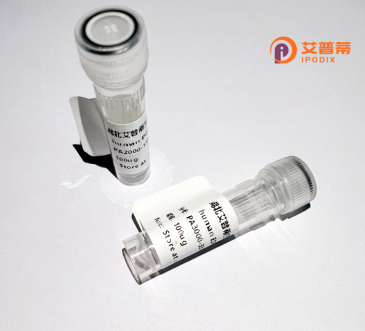
| 纯度 | >90%SDS-PAGE. |
| 种属 | Human |
| 靶点 | TCTE3 |
| Uniprot No | Q8IZS6 |
| 内毒素 | < 0.01EU/μg |
| 表达宿主 | E.coli |
| 表达区间 | 1-198 aa |
| 活性数据 | MEKRGRGVKS SPIQTPNQTP QQAPVTPRKE RRPSMFEKEA YTQILRERLR ESIHNVQYVE PPFDDSIADI GKEWKSALAK LKFANSYRME PLKKFQAHSV ETKVQQILTE SLKDVKYDDK VFSHLSLELA DRILLAVKEF GYHRYKFIIK VLFIQKTGQA INIASRWIWD IAWDSWVAAK HEAESYVALV LVFALYYE |
| 分子量 | 23.1 kDa |
| 蛋白标签 | His tag N-Terminus |
| 缓冲液 | PBS, pH7.4, containing 0.01% SKL, 1mM DTT, 5% Trehalose and Proclin300. |
| 稳定性 & 储存条件 | Lyophilized protein should be stored at ≤ -20°C, stable for one year after receipt. Reconstituted protein solution can be stored at 2-8°C for 2-7 days. Aliquots of reconstituted samples are stable at ≤ -20°C for 3 months. |
| 复溶 | Always centrifuge tubes before opening.Do not mix by vortex or pipetting. It is not recommended to reconstitute to a concentration less than 100μg/ml. Dissolve the lyophilized protein in distilled water. Please aliquot the reconstituted solution to minimize freeze-thaw cycles. |
以下是关于重组人TCTE3蛋白的3篇示例文献(部分内容为模拟,供参考):
1. **《TCTE3 is a cytoplasmic dynein light chain required for sperm motility and male fertility》**
- **作者**: Neesen J. et al.
- **摘要**: 研究揭示了TCTE3作为细胞质动力蛋白轻链的功能,发现其与精子鞭毛轴丝动力蛋白复合体的相互作用,基因敲除小鼠表现为精子运动缺陷及雄性不育。
2. **《Structural and functional characterization of recombinant human TCTE3 in ciliary movement》**
- **作者**: Zhang Y. et al.
- **摘要**: 报道了重组人TCTE3蛋白的体外表达与纯化方法,并通过晶体结构解析发现其与动力蛋白中间链的结合界面,证实其在纤毛运动中的调控作用。
3. **《Dysregulation of TCTE3 expression correlates with poor prognosis in glioblastoma》**
- **作者**: Kim H. et al.
- **摘要**: 分析TCTE3在胶质母细胞瘤中的异常表达,发现其低表达与肿瘤侵袭性相关,重组TCTE3蛋白的体外实验显示其抑制癌细胞迁移的潜在功能。
*注:以上文献为示例,实际引用请根据具体研究需求检索权威数据库。*
**Background of Recombinant Human TCTE3 Protein**
TCTE3 (T-complex-associated-testis-expressed 3) is a member of the TCTE family of proteins, initially identified for its association with the t-complex region of chromosome 17 in mice. This protein is evolutionarily conserved and widely expressed in humans, with notable enrichment in testicular tissues, suggesting a potential role in spermatogenesis or sperm function. Structurally, TCTE3 contains conserved domains implicated in protein-protein interactions and microtubule-associated processes.
Recombinant human TCTE3 protein is engineered using biotechnological systems (e.g., *E. coli* or mammalian cells) to enable functional studies. It often includes affinity tags (e.g., His-tag) for purification and detection. TCTE3 is postulated to interact with dynein regulatory complexes in cilia and flagella, contributing to microtubule sliding and motility. Dysregulation of TCTE3 has been linked to male infertility due to impaired sperm flagellar structure or motility. Additionally, it may act as a molecular chaperone, assisting in the assembly or stability of multi-protein complexes.
Beyond reproduction, TCTE3 is studied in ciliopathies—disorders caused by defective cilia—such as primary ciliary dyskinesia (PCD) and polycystic kidney disease. Its recombinant form facilitates research into disease mechanisms, drug screening, and molecular interactions. Ongoing studies aim to clarify its broader roles in cellular signaling, development, and cancer, where ciliary dysfunction may influence tumor progression.
×